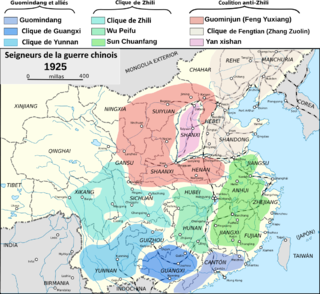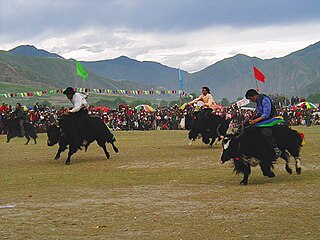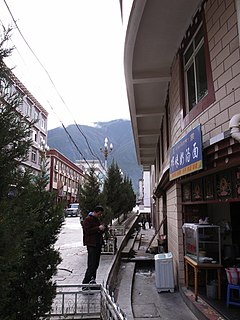Related Research Articles

Amdo is one of the three traditional regions of Tibet, the others being U-Tsang in the west, Kham in the east. Ngari in the north-west was incorporated into Ü-Tsang. Amdo is also the birthplace of the 14th Dalai Lama. Amdo encompasses a large area from the Machu to the Drichu (Yangtze). Amdo is mostly coterminous with China's present-day Qinghai province, but also includes small portions of Sichuan and Gansu provinces.

Kham is one of the three traditional provinces of Tibet, the others being Amdo in the northeast, and Ü-Tsang in central Tibet. The original residents of Kham are called Khampas, and were governed locally by chieftains and monasteries. Kham presently covers a land area distributed between five regions in China, most of it in Tibet Autonomous Region and Sichuan, with smaller portions located within Qinghai, Gansu and Yunnan provinces.

Xikang was an illusory province formed by the Republic of China in 1939 on the initiative of prominent Sichuan warlord Liu Wenhui and continued by early People's Republic of China. It comprised most of the Kham region, where the Khampa, a subgroup of the Tibetan people, live. The then independent Tibet controlled the portion of Kham west of the Upper Yangtze River. The nominal Xikang province also included in the south the Assam Himalayan region that Tibet had recognised as part of British India by the 1914 McMahon Line agreement. The eastern part of the province was inhabited by a number of different ethnic groups, such as Han Chinese, Yi, Qiang people and Tibetan, then known as Chuanbian (川邊), a special administrative region of the Republic of China. In 1939, it became the new Xikang province with the additional territories belonging to Tibetan and British control added in. After the People's Republic of China invaded and occupied Tibet, the earlier nationalist imagination of Xikang came to fruition.

Chushi Gangdruk is a Khampa Tibetan guerrilla warfare group, whose name translates as Four Rivers, Six Ranges, or the Kham Four Rivers, Six Ranges Tibetan Defenders of the Faith Volunteer Army.) Active since 1956, the Chushi Gangdruk guerrilla fighters were formally organized on June 16, 1958, and have been fighting the forces of the People's Republic of China (PRC) in Tibet since their beginning.

Tibet developed a distinct culture due to its geographic and climatic conditions. While influenced by neighboring cultures from China, India, and Nepal, the Himalayan region's remoteness and inaccessibility have preserved distinct local influences, and stimulated the development of its distinct culture.

Litang or Lithang County is in southwest of Garzê Tibetan Autonomous Prefecture, Sichuan, China. In 2001, it had a population of 47,500.

Yak racing is a spectator sport held at many traditional festivals of Tibet, Kazakhstan, Kyrgyzstan, Gilgit-Baltistan, Ladakh and Mongolia, in gatherings which integrate popular dances and songs with traditional physical games. For Tibetans in particular it is very special festive occasion.

The 1959 Tibetan uprising or the 1959 Tibetan rebellion began on 10 March 1959, when a revolt erupted in Lhasa, the capital of Tibet, which had been under the effective control of the People's Republic of China since the Seventeen Point Agreement was reached in 1951. The initial uprising occurred amid general Chinese-Tibetan tensions and in a context of confusion, as Tibetan protestors feared that the Chinese government might arrest the 14th Dalai Lama. The protests were also fuelled by anti-Chinese sentiment and separatism. At first, the uprising consisted of mostly peaceful protests, but clashes quickly erupted and the Chinese People's Liberation Army (PLA) eventually used force to put down the protestors, some of whom had captured arms. The last stages of the uprising included heavy fighting, with high civilian and military losses. The 14th Dalai Lama escaped from Lhasa, while the city was fully retaken by Chinese security forces on 23 March 1959. Thousands were killed during the 1959 uprising, although the exact number is disputed.

Batang Town, or Xiaqiong Town, is a town in Batang County, Garzê Tibetan Autonomous Prefecture, Sichuan Province, in the China on the main route between Chengdu and Lhasa, Tibet, and just east of the Jinsha River, or Upper Yangtze River. It is at an elevation of 2,700 metres.

Litang Town is the administrative centre of Litang County in the southwest of the Garzê Tibetan Autonomous Prefecture in Sichuan Province of China.

Yushu (Yüxü) is a county-level city of Yushu Tibetan Autonomous Prefecture in Southern Qinghai Province, China. It comprises a surface area of 13,462 square kilometres (5,198 sq mi). In 2010, the overall city's population was 120,447 and 56,802 live within the city core. There are around 356,000 people in the metropolitan area in 2020. Yushu is the fourth largest city in Qinghai.

The Ganden Sumtsenling Monastery, also known as Sungtseling and Guihuasi, is a Tibetan Buddhist monastery situated 5 kilometres (3.1 mi) from the city of Zhongdian at elevation 3,380 metres (11,090 ft) in Yunnan province, China. Built in 1679, the monastery is the largest Tibetan Buddhist monastery in Yunnan province and is sometimes referred to as the Little Potala Palace. Located in the capital of Diqing Tibetan Autonomous Prefecture, it is also the most important monastery in southwest China.

Jeff Fuchs is a Canadian explorer, mountaineer and writer. He gained prominence with his successful bid to become the first westerner to trek the entire Yunnan–Tibet Ancient Tea Horse Road, stretching almost six thousand kilometers through the Himalayas and a dozen cultures, documented in the book The Ancient Tea Horse Road: Travels with the Last of the Himalayan Muleteers (2008). He is also acting Asia-Editor-at-Large for Outpost Magazine.

The Ngolok rebellions (1917–1949) were a series of military campaigns against unconquered Ngolok (Golok) tribal Tibetan areas of Qinghai (Amdo), undertaken by two Hui commanders, Gen. Ma Qi and Gen. Ma Bufang, on behalf of the Beiyang and Kuomintang governments of the Republic of China. The campaigns lasted between 1917 and 1949.

George Neilson Patterson also known as Khampa Gyau and Patterson of Tibet, was a Scottish engineer and missionary who served as medical officer and diplomatic representative of the Tibetan resistance movement during the Chinese invasion of Tibet.

The Battle of Chamdo occurred from 6 to 19 October 1950. It was a military campaign by the People's Republic of China (PRC) to take the Chamdo Region from a de facto independent Tibetan state after months of failed negotiations on the status of Tibet. The campaign resulted in the capture of Chamdo and further negotiations between the PRC and Tibetan representatives that eventually resulted in the annexation of Tibet by the People's Republic of China.
The Batang uprising is an uprising by the Khampas of Kham against the assertion of authority by Qing China.

Rock Dog is a 2016 computer-animated comedy film produced by Mandoo Pictures and Huayi Brothers. The film is directed by Ash Brannon in his solo directorial debut, from a script by Brannon and Kurt Voelker. The film based on the Chinese graphic novel Tibetan Rock Dog by Zheng Jun, albeit its basic premise has been significantly altered. It features the voices of Luke Wilson, Eddie Izzard, J. K. Simmons, Lewis Black, Kenan Thompson, Mae Whitman, Jorge Garcia, Matt Dillon, and Sam Elliott. The film follows a young Tibetan Mastiff who leaves his mountain home village to become a rock musician in the big city after a radio falls from the sky.
Nyarong is a Tibetan historical river valley region located in Eastern Kham. It is generally equated with modern Xinlong County, which is called Nyarong in Tibetan, though the traditional region also includes parts of Litang County and Baiyü County.

Tenzing Tsondu, known professionally as Ding Zhen, is a Tibetan singer, Internet celebrity and businessman from Litang, Sichuan Province, China.
References
- Downs, James. "The Origin and Spread of Riding in the Near East and Central Asia." American Anthropologist. 1961.
- Horse Racing Fair and Archery Festival in Tibet
- Tours and information on races
- Horse tours